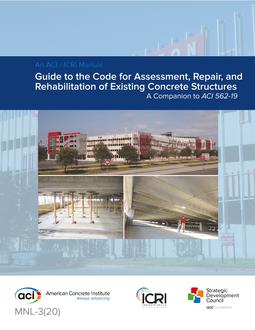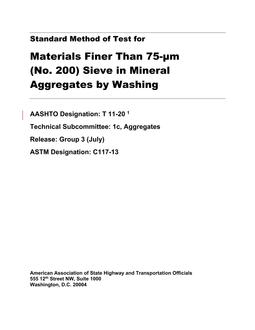Description
ACI MNL-3 – Guide to the Code for Assessment, Repair, and Rehabilitation of Existing Concrete Structures
Introduction to the ACI 562-19 Code
Advancements in the practice of assessment, repair, rehabilitation, and strengthening of concrete structures have developed through a collaboration of design professionals, contractors, suppliers, manufacturers, researchers, educators, and lawyers. The annual cost to owners for repair, protection, and strengthening of existing concrete structures is estimated between $18 and $21 billion (Vision 2020). Simply put, even sound concrete may require repair, rehabilitation, maintenance, or strengthening throughout the service life of a structure. Accordingly, from 2004 to 2006, the Strategic Development Council (SDC), an interindustry development group dedicated to supporting the concrete industry’s strategic needs, facilitated the development of “Vision 2020: A Vision for the Concrete Repair, Protection, and Strengthening Industry” to establish a set of goals that would improve the efficiency, safety, and quality of concrete repair and protection activities. One of the goals established by Vision 2020 was to create a concrete repair and rehabilitation code by 2015. The ACI 562-13 standard, “Code Requirements for Evaluation, Repair, and Rehabilitation of Concrete Buildings and Commentary,” is the end result of that initiative. ACI 562-19 is the third edition of the Code with revisions, additions, and reorganized information to enhance the Code, providing more clarity and additional, updated information to assist the design professional.
The purpose of the ACI 562 Code is to provide minimum material and design requirements for the assessment, repair, and rehabilitation of structural concrete members. Like other ACI codes, ACI 562 is organized in a dual-column format, with mandatory code provisions to the left of each page, and nonmandatory commentary to the right to provide additional guidance and information on the content presented in the Code provisions. Unlike other ACI standards, ACI 562 includes both prescriptive and performance requirements. The performance requirements provide great latitude and flexibility to the licensed design professional in satisfying the requirements of ACI 562. Accordingly, ACI 562 serves to unify and strengthen concrete assessment, repair, and rehabilitation projects while accommodating the diverse and unique strategies and materials used in the industry.
In general, the overall use and function of ACI 562, with respect to existing concrete structures, can be compared to that of ACI 318-19, “Building Code Requirements for Structural Concrete and Commentary,” with new concrete construction. As with ACI 318 and the 2018 International Building Code (2018 IBC), plans are underway for ACI 562 an ANSI standard, to be adopted into the International Existing Building Code (IEBC) to address matters pertaining to assessment, repair, rehabilitation, and strengthening of concrete members within existing buildings. Local jurisdictions and building authorities can also adopt ACI 562 directly. Cities and states have both adopted ACI 562 and adopted use of ACI 562 on specific projects. Other jurisdictions are in the process of reviewing the Code for consideration and adoption. Accordingly, while ACI 562 currently defines the standard for the concrete assessment, repair, and rehabilitation industry, the code provisions of ACI 562 will likely then become mandatory requirements as part of the governing building codes that regulate work in existing buildings.
Overview of the guide to ACI 562 Code content
The primary purpose of this guide is to help licensed design professionals (LDPs) gain more knowledge, skill, and judgment to interpret and properly use the ACI 562 Code. Although specifically developed for LDPs, this guide also provides insight into the use and benefits of ACI 562 for contractors, material manufacturers, and building owners and building officials. To achieve this goal, the guide is separated into three main components: Chapter Guides including Appendix A, Project Examples, and Appendix B, providing an overall view of the new standard, ACI 563, “Specifications for Repair of Concrete in Buildings.”
The Chapter Guides and Project Examples are provided in tandem for clarity and understanding of the relative portions of ACI 562 Code. The Project Examples illustrate the process of carrying out a concrete building assessment, repair, rehabilitation, or strengthening project from inception through completion. This guide, including the Project Examples, is intended as a supplement to the ACI 562 Code and not as a “how-to” manual for performing concrete assessment, repair, rehabilitation, or strengthening. Several additional documents are referenced in ACI 562 Commentary and this guide to assist in evaluating the various options and approaches to performing successful concrete assessment, repair, rehabilitation, or strengthening projects. The intent of each Project Example is not to be a prescriptive formula for each of the project scenarios presented, but to illustrate how various sections of ACI 562 are applied together to execute the project. For convenience, related provision numbers from ACI 562 are given at the top of each corresponding paragraph of the project example text. Eight Project Examples are included within the guide:
1. Typical parking structure repairs
2. Typical façade repairs
3. Repair of historic structure for adaptive reuse
4. Strengthening of two-way flat slab
5. Strengthening of double-tee stems for shear
6. Concrete beam repair by section enlargement
7. Concrete repair by steel jacket
8. Beam repair with fire protection analysis:
a. Beam strengthening due to live load increase
b. Beam with inadequate existing concrete cover
In the third edition of this repair guide, a new chapter, Appendix B, was added to address specifications. This is another goal by Vision 2020 to create a concrete repair specification standard. The ACI 563-18 standard, “Specification for Repair of Concrete in Buildings,” is a reference standard that the LDP can apply to any construction repair and rehabilitation project involving structural concrete by citing it in the Project Specifications. It provides direction to the contractor and clearly defines the responsibilities and scope of the repair, rehabilitation, or strengthening. The specifications detail the work, material, and installation required to complete a project the way the client wants.
The Chapter Guides follow the general organization of ACI 562, broken down by the corresponding sections of ACI 562. Section numbers in Chapters 1 to 10 and Appendix A of this guide correspond to the provision numbers in ACI 562. The Chapter Guides include background information and an explanation of the various ACI 562 provisions, with particular insight into how the particular chapter and section of the Code fit within the project. Where applicable, flowcharts are provided to illustrate how to navigate the various provisions of ACI 562. References to Project Examples are provided where applicable to illustrate how specific provisions within each chapter of ACI 562 are incorporated into the design process. In some instances, additional limited-scope examples are included to better illustrate a point that is not covered by the Project Examples.
The first edition of ACI 562 was published in 2013, and was not available when the work for the projects discussed in the Project Examples was actually performed. All Project Examples assume that ACI 562 was available and accepted by local jurisdiction when the example projects were performed.
The second edition of ACI 562, published in 2016, includes additional definitions used in the Code for consistency with 2018 IEBC and other similar standards for existing structures. The title of ACI 562-16 was changed by replacing the word “Evaluation” with “Assessment.” The two terms, which are used interchangeably by other standards and the first version of this Code, have received distinct definitions in the second edition of ACI 562 (Stevens et al. 2016). Specific criteria requirements for assessment and design of repair and rehabilitation for varying levels of damage, deterioration, or faulty construction was added in Chapter 4 when using the Code with IEBC, and in Appendix A when using the Code as a stand-alone code. Chapters 1 and 4 were revised to include specific criteria requirements for assessment and design of repair and rehabilitation for varying levels of damage, deterioration, or faulty construction. Load combinations in Chapter 5, which define the minimum strength of a structure with unprotected external reinforcement, were revised. Chapter 6 directs the LDP to provide an assessment before rehabilitation of an existing structure. This chapter includes historical material property data to help the design professional in the assessment if existing documents related to the existing structure are not available or physical samples cannot be extracted, because of the historical value of the structure. The interface bond provisions in Chapter 7 were revised to provide specific requirements based on shear test, as well as when to provide interface reinforcement, and commentary in Chapter 8 was clarified.
The third edition of ACI 562, published in 2019, has:
(a) Added text to simplify use of new materials that have the equivalent of an ICC-ES evaluation report in Chapter 1;
(b) Simplified the requirements for the basis of design reported in Chapter 1;
(c) Clarified requirements related to detailing of existing reinforcing steel in Chapter 7; and
(d) Updated commentary in Chapter 8 to include a listing of exposure categories that may affect durability.
In addition, three new repair examples are added to demonstrate the flexibility of the Code and its applicability to different repair and strengthening methods. Example 6 is related to concrete beam repair by section enlargement, Example 7 addresses concrete frame strengthening by steel jacketing, and Example 8 focuses on the effect of fire on concrete members and possible protection based on two scenarios: scenario one—concrete structure subjected to increase in live load; and scenario two—reinforcement with low concrete cover.
Lastly, a summary of the various provisions of ACI 562, as well as the corresponding location where each provision is covered within the guide, is provided in the Provision Coverage Matrix at the end of this guide. This serves as a useful tool when searching for additional information to a specific provision of ACI 562.
Product Details
- Published:
- 11/01/2020
- ISBN(s):
- 9781641951210
- Number of Pages:
- 226
- File Size:
- 1 file , 79 MB
- Note:
- This product is unavailable in Russia, Ukraine, Belarus




